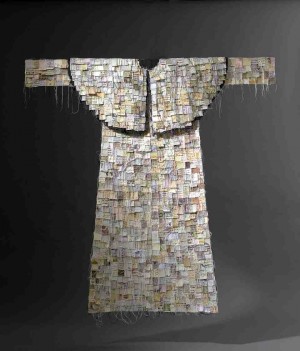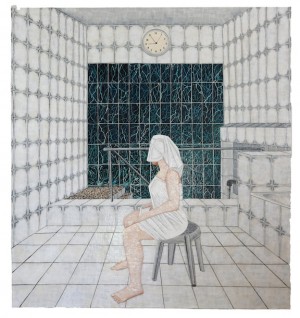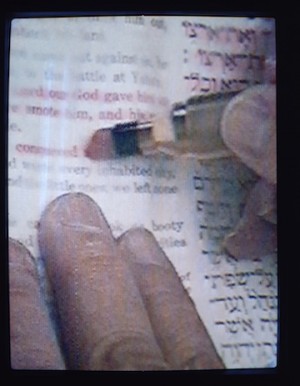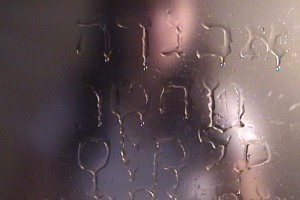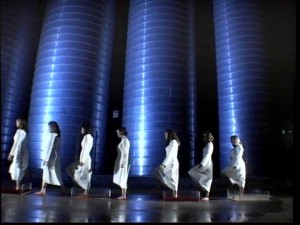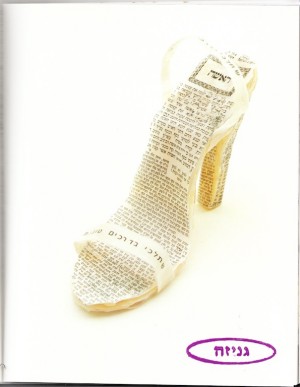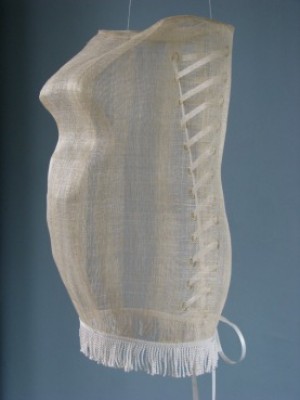Feminist Art in Traditional and Religious Judaism
Jewish feminist art by women active in the traditional religious world is still a marginal phenomenon in the general art world and in the Israeli art field in particular. This article, together with the first major exhibit in a museum to exhibit such work, “Matronita: Jewish Feminist Art” (The Museum of Art Ein Harod), which I co-curated, invites a reflection on the complexities of the feminist Jewish religious experience.
First, by “traditional religious world,” I refer to the world conventionally referred to as “neo-Orthodoxy.” However, such conventional classifications have become quite fluid over the years, and most female artists creating art in the traditional and religious spheres wander between an acceptance of Orthodox Halacha (Jewish law) as an authority and a view of it as a tradition, an inspiration or even a discourse to be critiqued. Indeed, most religious-feminist artists combine modernism (or post-modernism) and traditionalism to generate an intermediate state, in which liberalism, curiosity and a critical stance are intermingled with traditional, at times conservative, elements. This combination produces an internal tension that serves as a fertile ground for subversive and stimulating art. Moreover, most radical artworks by religious female artists nowadays are part of a “post-secular” discourse, in which “secularism” and “religiousness” are no longer perceived as opposites but as inextricably intertwined. At the same time, one must acknowledge that while religious female artists deal extensively with issues of feminine identity and even engage in criticism of male hegemony in their society, this often stands in contrast with an acute lack of discourse about sexuality and gender relations in the religious sphere.
Feminist art currently created in the religious community is a wide, multifaceted world that cannot be reduced to any single practice or outlook. It has a radical, even militant component that connects it to its roots in radical 1970s feminist art, yet an extensive branch of this art is characterized by a conciliatory, minor voice. Western feminist art has addressed many topics, such as the exclusion of women from society’s dominant discourse and the regulation of their bodies and sexuality, the body and sexuality, subject-object relations, the dominance of male hegemony, or the economy of art production. The latter issue was manifested most emphatically in re-appropriating crafts such as ceramics, embroidery, sewing and knitting into the world of art. Also addressed were issues such as the myth of beauty and normative physical dimensions, and patriarchal positions on menstruation blood. Jewish feminist art participates in the discourse about several of these same issues. It not only designs feminist ceremonial art, but also questions the visibility of women, reads anew mythological figures of women, and discusses halachic issues such as niddah and tevilah, head covering, agunot, halachic infertility, women’s prayers, the marginality of women in ceremonies and their exclusion from Torah studies. Queerness, another key issue in American discourse about contemporary Jewish identity that has lately entered rabbinical discourse in Israel (under the new terminology of “inverted tendencies”), has been expressed in Israeli feminist religious discourse and in Israeli art in general but has hardly been addressed by the art created in Israeli religious society. To date there have been only the most preliminary signs of works reflecting the values and ideas of queer theory and identity.
The term matronita appears in dozens of midrashim and in Jewish literature throughout the centuries, in two main roles: as a woman of excellence who holds discussions with sages, and as a queen, the partner of the king. The matronita is therefore a woman who represents a complex identity and a fascinating abundance of human life experience, a woman who experiences exaltation and loss, pain and satisfaction; and although the original word referred to a Gentile woman, the Jewish tradition did not hesitate to elevate the figure to the status of a symbol and an exemplar to the Jewish people. the Matronita consistently appears throughout the Talmud as a gadfly or devil’s advocate. She inquisitively interrogates the sages with all kinds of questions peppered with grace and a dash of humor. The Matronita character serves as a foil to create intellectual challenges which are welcomed by the sages and spark discussion among them. While the Talmudic Matronita is never a Jewish woman, our exhibition follows in her footsteps. The “Matronita” exhibition is about women held in high esteem, who ask questions and raise key issues concerning feminine equality. At times, this is done provocatively; at others - with humor, but all the art we display opens up a discourse about the relationship between women and Jewish ideas and values. “Matronita”, the exhibition at the Museum of Art, Ein Harod — like the Talmudic matronita — infuses a vital power of spirit and a depth of thought into the ancient Jewish culture, deconstructs stereotypes, and provokes confrontation with a changing reality. Our exhibition invites discussions that challenge authorities, taboos and the status quo, just as the Talmudic Matronita provided the sages with an opportunity to launch their own debates and deliberations. The “Matronita” exhibition poses disturbing questions that may change the way people think, and hopefully will help create a better world for our daughters and sons.
I will now address some of the prominent trends in this genre of artistic production.
Undermining Tradition by Engaging with It
Contemporary art created by Jewish feminist women differs from the feminist art that preceded it in at least one significant aspect: while most Jewish feminist women artists, much like the majority of Jewish feminist women thinkers, had previously focused on feminism rather than Judaism, the greater part of feminist artworks created by women in the present-day religious community combines a critical feminist perspective with an emphasis related to Jewish culture. At the same time, women artists in the religious sphere — despite working within the confines of religion or tradition — often do not comply with conventional constructs, frequently undermining the etymological connection between the Hebrew words for art (omanut) and belief (emuna) and even defying the Halacha and its attitudes toward women. In the Jewish traditional world, daily religious ceremonies, much like language, become second nature, practically transparent and indisputable. The art created within this world, however, is often an undermining practice, constantly reevaluating tradition and striving to give it new form.The radical aspect in the work of some of these women artists is further accentuated against the backdrop of feminist endeavors in other cultural fields. While neo-Orthodox women’s exegeses often focus on “feminine” interpretations of the Bible, rabbinic literature and halachic discourse, which only offer minor, gradual changes of halachic law, the discourse of religious Jewish art frequently raises more subversive ideas, undermining the very foundations of male positions of power.
Helène Aylon (b. 1931), who was raised in an Orthodox home, is quite prominent among American artists engaged in a feminist critique of Jewish tradition and ceremonies. Two of her works — The Liberation of G-d (1990–96), in which she highlighted with a marker Bible verses that offend her humanist and feminist outlook, and All Rise! Beit Din as a “House” of Three Women (2007–09), a furniture piece representing a new Beit Din (religious court) headed by women — have been exhibited by several central museums in the United States.
Shown at right is the most commanding — some would say controversial — work of this project, the installation “The Liberation of G-D,” comprising multiple volumes of the Five Books of Moses that form the Torah. Aylon has gone through them, page by page, patiently, exactingly, using a pink magic marker to cross out passages that she feels were inserted by a misdirected male hierarchy. The words she questions are vengeful, deceptive, cruel: Do they belong in a holy book? “Did God say it to Moses, or is it a patriarchal projection?” she asks. To either side of the altered books, videos record Aylon’s hand guiding the marker, at times in slow rhythm, at times agitatedly. The scratch of the marker, crinkle of parchment, add to the room’s sensory surround, a quality evocative of ritual.
Aylon’s works should be read while bearing in mind the cultural and religious significance she ascribes to the sacred text and to the Beit Din as an establishment. Aylon marks the text, perhaps even censors it (metaphorically, without actually staining the sacred text itself), as if trying to save the text from itself or liberate God from patriarchy’s appropriation. Thus, she raises the question of women’s representation in the Jewish world and suggests an alternative, which is in fact a Tikkun or reparation.
Hadassa Goldvicht’s Writing Lesson No. 1 shows Goldvicht licking honey letters off a glass pane, recreating the ceremony in which Jewish boys, when taken to school for the first time, lick off the honey that the teacher has spread over the letters of the Hebrew alphabet. This was meant to ensure that their Torah learning would be sweet. Unlike boys, girls did not participate in any elaborate ritual to mark a new stage in their lives, so it was quite striking to see a woman licking those letters of the alphabet. This beautiful, poetic custom is centuries old and was practiced throughout the years in different continents. It sent a clear, negative message to little Jewish girls everywhere: that the Torah’s sweetness was not theirs to enjoy. Goldvicht stakes her equal claim and appropriates the ritual for all Jewish women; she empowers them by asserting their birthright to a Jewish education. Goldvicht, who plays the part of the pupil in her video, did not choose to become its subject because of her gender, but rather because she knew best exactly how she meant the role to be played. Her motivation was not purely feminist; she “attempted to create a distilled image of the body as it yearns for the divine in its initial form — the alphabet.” Seen through a feminist lens, the woman’s enactment of the ceremony may draw us closer towards reaching the unattainable divine.
Minority Identity: The Problematization of “Otherness”
Neo-Orthodox female artists in Israel are part of a cultural minority in a predominantly secular society. While local artistic discourse has made room for Jewish contents, this has mostly involved — as I have claimed elsewhere — processes of “hybridization” and “purification.” Quite unlike the art created in the hegemonic center, the art created in the religious sphere does not adopt this discourse by turning itself into a modern-secular expression; its religious contents and critique remain marked and direct. At the same time, despite being created in a marginal society, this art employs materials and creative modes typical of the dominant language, and takes part in its discourse. Female artists in the religious community operate within the general discourse of art, are aware of and take an active part in it. Nevertheless, while this creative sphere is patently connected to the general field of art, its attitude regarding the religious world — particularly the Halachic world, which is mostly foreign to Israelis and to the discourse of art in Israel — is deliberately manifest. This is therefore a marginal art that originates in an internal cultural world that is aware of its otherness and aspires to remain critical and non-assimilated. And when the content of this art reaches beyond the bounds of its “sector,” as it often does, it is due to the assumption that the Jewish outlook is, albeit latently, the underlying foundation and structure of Israel’s society and culture.
In her video art Five plus Seven (2004), Hagit Molgan showed three women, heads hidden, wearing white dresses with a cut-out square exposing stomach and navel (symbolizing the womb, perhaps). The women march in file among bowls containing red water and containers of clean water, but their feet are stained red even after contact with the water. Showing blood in the Jewish contexts in Molgan’s works cries out against male dominance, represented (inter alia) by the rabbinate’s “kosher” seals smeared in red ink. Transposing objects from the context of religious worship to that of art opens the underlying assumptions to discussion and criticism.
A Love that Does Not Corrupt
Over the last decades, there is an evident tendency among feminist women artists operating in the Jewish context to address taboo subjects from a radical point of view. While these artists differ from one another in both worldview and means of expression, most share a critical view of halachic Judaism, or at least of certain elements of it. A scrutiny of the differences between religious-feminist and secular-Israeli art does not confirm common dichotomous distinctions between validation of tradition on the one hand, and, on the other, freedom and defiance. The fundamental difference between these worlds stems from a different view regarding the historical dialogue with secularism: while the hegemonic secular discourse focuses on the question of tradition’s validity and thus often produces defiant art, the religious branch turns the spotlight on issues related to the ways in which tradition develops and strives to form Judaism in its own way. Most radical artworks by religious female artists are, as mentioned above, part of a complex “post-secular” discourse, which does not contrast between “secularism” and “religiousness” but rather views them as interrelated notions. Against this backdrop, acts that may at times appear to be provocative or anti-halachic are not perceived as such by the artists themselves, who, while operating within or alongside the halachic sphere do not adhere to its rigid rules. They regard their works as “a love that does not corrupt”.
Nechama Golan (b. 1947), one of the most prominent religious Israeli artists, rejects any rigid constructs of “religiousness” and incorporates printed religious texts in her work. The work You Shall Walk in Good Ways (1999) is an example of the complex subversiveness of her feminist stance. Seemingly a common high-heeled shoe, the work is made in fact of glued-together layers of photocopied Talmud pages from Tractate Kiddushin (marriage). Juxtaposing the uncomfortable shoe that limits women and regulates their image as objects of desire with the Talmudic text on marriage and its traditional view of it as ownership, the work is a metaphor of the rules and tenets imposed on women by the patriarchal culture — both religious and secular. Golan’s use of the sacred text is not an act of defiance or desecration, but a critical practice, much as these texts are dealt with in postmodern feminist prayers and exegeses, at times even in traditional interpretive commentaries. In Golan’s work, the sacred texts exceed their status as “raw material” and become the very essence of the artwork. Merging the spheres together, she turns the halachic practice into an integral part of her work of art: halachic notions become artistic practices, and vice versa.
In Jacqueline Nichols’ Maternal Torah: The In-between Yeshiva, a sefer torah corset is based on a pregnant woman’s shape. Nichols writes that “In the Talmud in Niddah 30a, the fetus is poetically described as learning torah from an angel in the womb. On exiting, the angel strikes the baby, forming the indent in the upper lip, causing the baby to forget all the knowledge that it once knew. I have always understood this piece from the fetus’ perspective. We are to spend our lives retrieving the knowledge that was once ours. Torah is not a new thing for us, but a retracing of prior learning. Perhaps it was due to my experiences of pregnancy, but I have revisited this Talmud, thinking about it from the mother’s point of view. Throughout the pregnancy, her body is a place of revelation, a makom torah, a primal beit midrash for the fetus. Its own personal Mount Sinai. As she writes: “The Torah is often described as a feminine object. The Torah is held, kissed, symbolically married, dressed and undressed for each ritual usage. The design of the cover as an elaborate corset seems to me to be a perfect metaphor for Torah’s role in our lives - it gives shape, support, and constrains.”
A New Multiculturalism?
“The multicultural revolution seems to have completed its course in Israel too, and has become trivial,” asserts art Historian Gideon Ofrat in a recent essay, claiming that sectors previously excluded by society (women, Mizrahi Jews, LGBT, Russians, Palestinians) are a thing of the past. “In the 1970s, the status of women artists in Israel was reversed and they have since populated the art schools more and more, gradually taking the lead in Israeli art.” But numbers are only part of the picture, and the difference between inclusion and influence is reflected in the widespread disavowal of feminism among Israeli women artists in the 1970s. In reality, the profusion described by Ofrat does not generate a genuine multicultural discourse, and we are nowhere near a hegemonization that includes women artists in Israeli museum collections (for instance). It is therefore hard to concur with Ofrat’s claim that multiculturalism has become a “beat-up intellectual carcass.”
Multiculturalism does not manifest itself merely in equal numbers or in equality before the law, nor does it boil down to the visibility of marginal groups; rather, it should be a celebration of “cultural exchange,” a plurality of cultural difference that allows diverse aesthetic and ethical worldviews to coexist without foregoing the backbone of self-identity. The proper question is not the extent to which marginal groups are excluded, but to what extent Other (aesthetic, poetic, ideological) cultural stances are able to take their proper place in the local art discourse. The answer to this is far from positive, and feminist Jewish art is a clear case in point.
However, despite the marginal position of religious feminist art within the larger field of Israeli art, this art is already assuming a central place within Jewish cultural discourse. At its best, it is a mouthpiece for an ethical “truth” that undermines and questions the hegemonic voice, an act that is often perceived as the most unique, radical, subversive, and vibrant contribution of religious feminist art to the field of Jewish art.
The Exhibition “Matronita: Jewish Feminist Art” (curators: Devora Liss and David Sperber) is being exhibited in the Mishkan Le-Omanut, Ein Harod, until the end of April. In the framework of the exhibition the museum published a detailed catalogue on the theme of the exhibition. The catalogue may be purchased at museumeinharod.org.il.
![[the current issue of ZEEK]](../../image/2/100/0/5/uploads/leftistethicistgraphic-52842c6a.png)
- 5000 Pages of Zeek
- Founded in 2001, Zeek was the first Jewish online magazine, and we have over 5000 pages online to prove it, all available free of charge. Read more in the Archive.
More articles by
David Sperber
More articles in
Arts and Culture
- Euphoria, Curiosity, Exile & the Ongoing Journey of a Hasidic Rebel: A Q & A with Shulem Deen
- Poet Q, Poet A: Jews Are Funny! Six Poets on Jewish Humor, Poetry & Activism and Survival
- Tackling Hate Speech With Textiles: Robin Atlas in New York for Tu B’Shvat
- Fiction: Angels Out of America
- When Is an Acceptance Speech Really a Speech About Acceptance?


